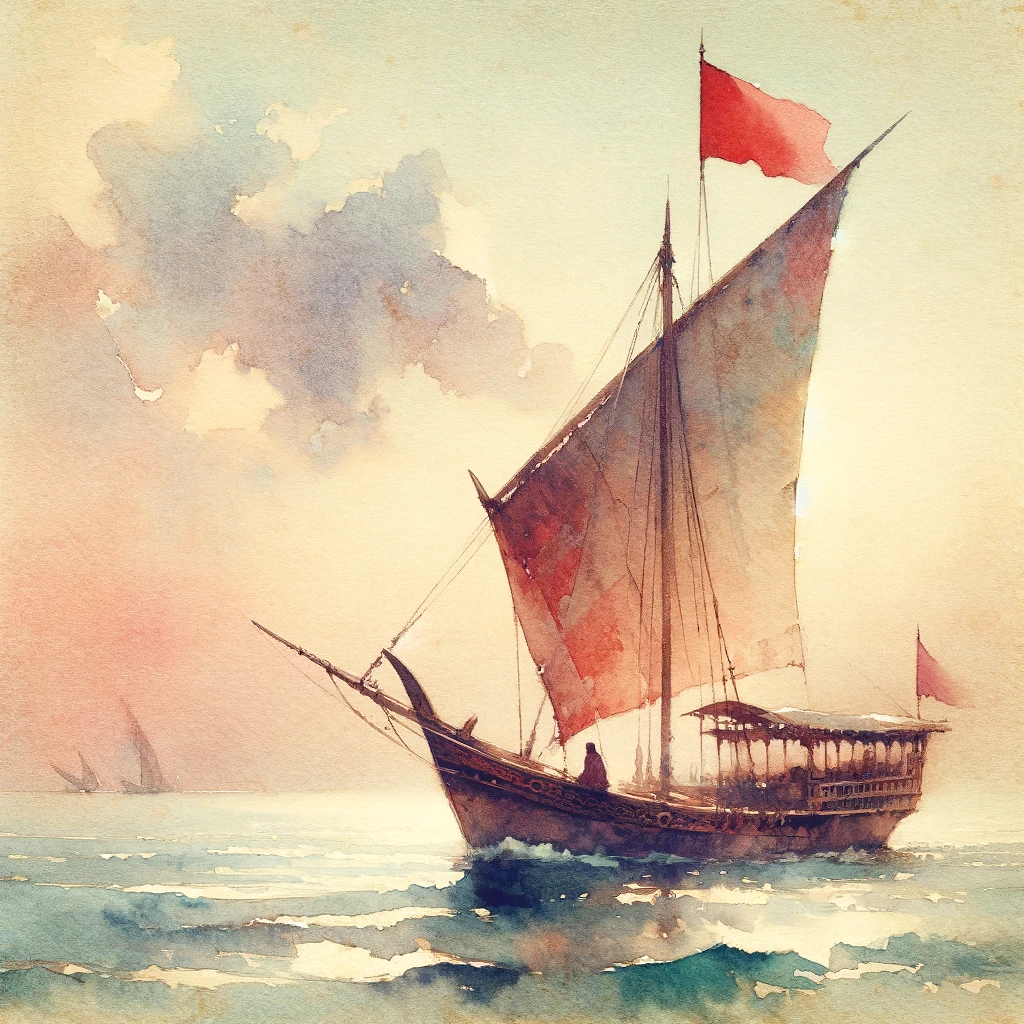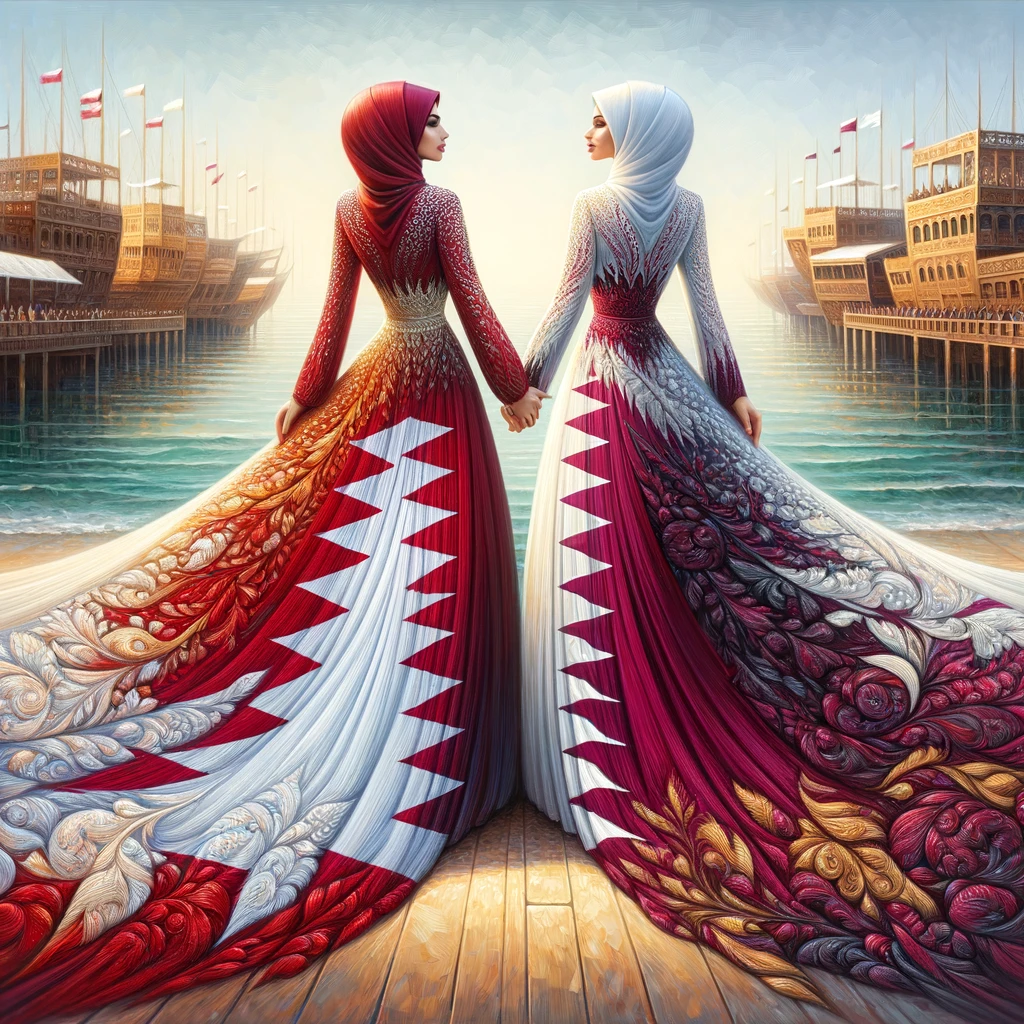Nestled in the heart of the Persian Gulf, the nations of Bahrain and Qatar share not only geographical proximity but also a rich tapestry of history and culture that is vividly reflected in their national flags. These flags, while seemingly similar at a glance, unravel stories of Islamic heritage, British treaties, and unique national identities shaped over centuries. The traditional colour of red, the symbolic white stripe, and the distinct serrated edges offer a window into the past, embodying the spirit and values of the Bahraini and Qatari people. This essay delves into the historical evolution, similarities, and differences of the Bahrain and Qatar flags, exploring the profound symbolism and design elements that distinguish each flag. Through an examination of the flags’ origins, including the influence of the Khārijite sect and British directives, to their current representation of national identity, we uncover the essence of what these symbols mean to each nation.
| Feature | Bahrain | Qatar |
|---|---|---|
| Year Adopted | 2002 | 1971 |
| Initial Color | Red | Red |
| Current Main Color | Red | Maroon |
| White Stripe | Yes | Yes |
| Serrations | Five | Nine |
| Symbolism of Serrations | Five Pillars of Islam | Historical conflicts and inclusion as the ninth member of the Emirates of Trucial Oman |
| Unique Characteristics | Bright red color; Initially had 28 points, reduced to 8 in 1972, and to 5 in 2002 | Unique maroon color influenced by environmental factors; Known for its longer flag proportion |
Historical Evolution of the Flags
Origins of Plain Red Flags
The initial choice of plain red for the flags of both Bahrain and Qatar was deeply rooted in the region’s Islamic heritage. This colour was emblematic of the Khārijite sect, a group with a formidable presence in the Arabian Peninsula. The stark red banner served not only as a symbol of the sect’s influence but also as a bold statement of power and unity among its followers. This commonality between Bahrain and Qatar highlights a shared historical and religious backdrop that laid the foundation for the development of their national symbols.

Bahrain’s Flag Evolution
The transformation of Bahrain’s flag began in a significant year, 1820, marking a pivotal moment in the nation’s history. The addition of a white stripe was a direct result of the peace treaty signed with the British Empire, symbolising a new era of peace and diplomacy. This alteration not only distinguished Bahrain’s flag from those of pirates but also signified its sovereign status and willingness to engage in international relations. The evolution continued in 1932, with the introduction of a serrated edge to the flag, a design choice aimed at further differentiating Bahrain from its neighbours. This distinctive feature, alongside the reduction of white points over time to symbolise the Five Pillars of Islam, encapsulates Bahrain’s journey towards forging a unique national identity.
Qatar’s Flag Evolution
Qatar’s flag underwent its own series of modifications, beginning in the 19th century with the introduction of a white vertical stripe. This change, while aligning with British directives, also served to mark Qatar’s distinct identity within the Gulf region. The flag’s evolution saw the integration of nine-pointed serrated edges, diamonds, and the word “Qatar” in its design in 1932, elements that were later streamlined to focus on the maroon colour and serrated edge. The official adoption of the current flag in 1971, with its unique maroon shade and specific height-to-width proportion, was a culmination of Qatar’s historical influences, including its role in dye production and its status within the Emirates of Trucial Oman. This evolution reflects Qatar’s rich cultural heritage and its path to national unity and independence.
Similarities Between the Flags
Despite their unique evolutionary paths, the flags of Bahrain and Qatar share several notable similarities that stem from their shared historical and cultural contexts. These similarities not only highlight the interconnectedness of the two nations but also underscore common themes in the region’s flag traditions.
Shared Historical Use of Red
At the heart of both flags is the color red, a hue deeply entrenched in the Islamic heritage of the Arabian Peninsula. This color choice harks back to the days when the Khārijite sect wielded significant influence, symbolizing both the unity and the martial spirit of the communities under its sway. The use of red in both flags serves as a nod to this shared historical backdrop, emphasizing a common identity rooted in the early Islamic tradition.

White Stripe for Peace
The incorporation of a white stripe in both flags stands as a symbol of peace and a testament to the historical treaties with the British Empire. In Bahrain’s flag, the white stripe was introduced in 1820 to signify the peace treaty with Britain, marking a departure from the era of piracy and conflict that characterized the Gulf waters. Similarly, Qatar’s flag incorporates a white stripe, underscoring the nation’s commitment to peace and its distinct identity amidst the British influence in the region. This element of design unites the two flags in their common historical journey towards sovereignty and international recognition.
Serrated Edges
A distinctive feature of both flags is the presence of serrated edges, a design choice that sets them apart from the flags of other neighboring countries. These serrated edges are not merely decorative but carry deep symbolic meaning, representing the ruggedness and resilience of the nations they symbolize. In Bahrain’s flag, the five serrated edges correspond to the Five Pillars of Islam, integrating the nation’s religious convictions into its national symbol. Qatar’s flag features nine serrated edges, symbolizing its historical battles and its status as the ninth member of the Emirates of Trucial Oman. This shared design feature reflects a mutual desire to highlight national uniqueness and historical depth through the flags’ aesthetics.
These similarities underscore a shared narrative of Islamic heritage, peace through treaties, and a desire for national distinction, encapsulated in the flags of Bahrain and Qatar. While they share these common threads, the nuanced differences in their designs and symbolism speak volumes about each nation’s unique identity and historical journey.
Differences in Design and Symbolism
Despite the apparent similarities, the flags of Bahrain and Qatar exhibit distinct differences in design, symbolism, and color schemes, each reflecting the unique historical, cultural, and religious narratives of the respective nations.

Color Differences
- Bahrain’s Vibrant Red: Bahrain’s flag features a bright, vivid red, a choice that aligns with the traditional Islamic symbolism and the nation’s historical ties to the Khārijite sect. This color not only represents the sect’s influence but also Bahrain’s rich history of battles and its vibrant Islamic heritage.
- Qatar’s Unique Maroon: In contrast, Qatar’s flag boasts a unique shade of maroon, officially recognized as “Qatar maroon”. This distinctive color choice is deeply rooted in the country’s historical connection to the dye production industry, particularly the purple dye derived from shellfish. The maroon color is symbolic of Qatar’s adaptation to climatic influences, where the intense sun caused the originally poor-quality red dye to fade into a unique maroon, embedding a piece of Qatar’s environmental and economic history into its national flag.
Serrated Edge Symbolism
- Bahrain’s Five Triangles: The five serrated edges on Bahrain’s flag are not merely decorative but are imbued with deep religious symbolism, each point representing one of the Five Pillars of Islam. This design element integrates Bahrain’s strong Islamic faith into its national symbol, reflecting the country’s commitment to its religious foundations.
- Qatar’s Nine Serrated Edges: Qatar’s flag, on the other hand, features nine serrated edges, each symbolizing a significant aspect of the nation’s history. The number nine represents Qatar’s inclusion as the ninth member of the Emirates of Trucial Oman, a historical acknowledgment of its geopolitical standing. Additionally, these edges pay homage to the numerous historical conflicts Qatar has faced, reflecting the nation’s resilience and its journey towards sovereignty.

Cultural and Historical Significance
- Bahrain’s Emphasis on Islamic Heritage and Battles: The design and colors of Bahrain’s flag highlight the nation’s Islamic heritage and its historical narratives of conflict and unity. The flag serves as a symbol of Bahrain’s identity, rooted in its religious traditions and its storied past, marked by battles for independence and sovereignty.
- Qatar’s Reflection of Culture, Patriotism, and Heritage: Qatar’s flag is rich in cultural symbolism, reflecting not only the nation’s history of wars and achievements but also its deep-rooted patriotism and heritage. The maroon color and the flag’s design elements embody Qatar’s pride in its land, people, and the historical significance of its dye production industry, symbolizing a nation that cherishes its past while looking confidently towards the future.
These differences in design and symbolism between the flags of Bahrain and Qatar highlight the unique paths each nation has taken in forging its identity and narrating its history through its national symbols. The flags stand as testament to the rich tapestry of Gulf history, culture, and religious tradition, with each element carefully chosen to reflect the distinct values and heritage of Bahrain and Qatar.
The Flags’ Representation of National Identity
The flags of Bahrain and Qatar are not merely symbols of state but deeply ingrained representations of each nation’s identity, reflecting their historical legacies, cultural values, and aspirations for the future. Through their distinct designs and symbolism, these flags narrate the unique stories of two nations bound by geography yet distinguished by their diverse paths.
Bahrain’s National Identity
- Symbol of Islamic Principles: Bahrain’s flag, with its vibrant red and the five serrated edges symbolising the Five Pillars of Islam, serves as a powerful emblem of the nation’s Islamic faith and principles. This design element underscores Bahrain’s deep-rooted religious identity and its commitment to the values and teachings of Islam.
- Historical Significance: The flag also embodies Bahrain’s rich history, from its early Islamic influences to its role in regional conflicts and its status as a sovereign nation. The transition from a plain red flag to the current design mirrors Bahrain’s journey through time, highlighting its historical struggles for independence and its achievements in establishing a distinct national identity.
Qatar’s National Identity
- Representation of Heritage and Aspirations: Qatar’s flag, with its unique shade of maroon and nine serrated edges, encapsulates the nation’s pride in its heritage and its aspirations for the future. The flag reflects Qatar’s historical connection to the dye industry, its climatic challenges, and its achievements in overcoming adversity to emerge as a unified and sovereign state.
- Cultural and Patriotic Symbol: Beyond its historical and climatic significance, the flag stands as a testament to Qatar’s rich culture, patriotism, and the enduring spirit of its people. It symbolises the nation’s journey from a collection of tribes to a modern state that values its traditions while embracing progress and development.
Both flags, through their distinctive features, serve as focal points of national pride and identity. They not only signify the sovereignty and independence of Bahrain and Qatar but also celebrate the unique cultural, historical, and religious narratives that define each nation. In doing so, these flags foster a sense of unity and belonging among their citizens, serving as constant reminders of their shared heritage and collective aspirations.

Conclusion
The flags of Bahrain and Qatar stand as vibrant testaments to the rich tapestry of history, culture, and religion that characterises the Persian Gulf region. While sharing similarities that reflect their geographical proximity and Islamic heritage, it is the nuanced differences in their design and symbolism that reveal the unique identity and historical narratives of each nation. Through their flags, Bahrain and Qatar continue to narrate their distinct stories, contributing to the diverse and rich mosaic of national identities in the Gulf region.

